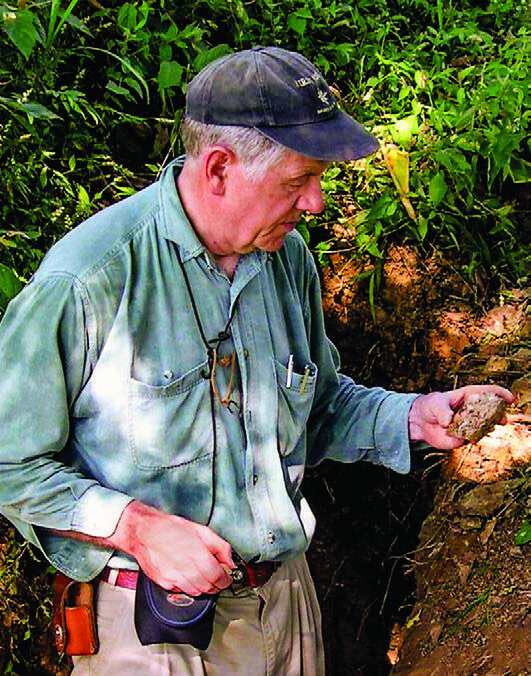
Peter Bradshaw was inducted into the Canadian Mining Hall of Fame in 2015 as an accomplished mine-finder and developer, company builder, advocate of collaborative research and science, and pioneer of corporate social responsibility (CSR). But as he candidly admits, he once struggled to understand the importance of social issues and the need for them to be integrated into the mine-planning process.
It was 1979 and Bradshaw had joined Placer Development and been deployed to the Adanac molybdenum project in northwestern British Columbia. He was surprised to find opposition to the project in a region with a rich gold-mining heritage.
“The nearest town was Atlin and a newspaper had opened up just to oppose the mine,” Bradshaw says. “I was a young geologist at the time and this took me aback.”
By this point, Bradshaw had a PhD in economic geology and a decade of international experience with Barringer Research. He had been involved with environmental issues as an exploration geochemist with the Toronto-based consulting firm, but Adanac (since renamed Ruby Creek) posed a new and unexpected set of challenges.
“Placer was then working around the world and becoming a leader in recognizing social issues,” Bradshaw says. “Rather than confront opponents [at Adanac], they hired a consulting sociologist. The guy went up there and found 60 per cent of people opposed the mine, 30 per cent were for it and 10 per cent didn’t know.”
Bradshaw was skeptical when the consultant suggested conducting a series of open houses and putting up posters to explain the various aspects of the project. “I went to the first open house expecting to be really confrontational, but kept my cool. I saw that people just wanted information. When rumours fly, the natural tendency is to be suspicious, and if you get the brushoff, you get even more suspicious.”
Three open houses were held over the summer and the end result was a new poll showing 60 per cent approval for the project, with only 30 per cent opposed.
“That was a real object lesson of the need to consult often and as necessary,” Bradshaw says. “The first thing is that people want information, and they want it in a way they can consume it. Another rule is to never tell a lie. If arsenic is going to be a problem, tell them, and explain the steps that will be taken to mitigate the problem.”
Bradshaw says this was a turning point that helped him realize that 50 per cent of working with communities is a mindset, and not stuff from a manual. “I realized that it was part of my job description to take the time to stop and talk and listen.”
Those lessons learned proved valuable as Bradshaw moved on to more challenging projects, notably Placer’s Porgera and Misima gold projects in Papua New Guinea.
Misima was relatively easy, Bradshaw says, as the small island had a historic gold mine and many people spoke English and had exposure to western culture. The main concern was the potential for social disruption from an influx of jobseekers. The company offered employment to locals first, and it was the locals who decided not to allow outsiders in unless they had a job offer at the mine or family ties to the island.
“Porgera was another story,” Bradshaw says. “It’s located in the Highlands, and of the 2,000 people who lived there during the exploration phase, I don’t think a single one spoke English, or even pidgin, the lingua franca [of Papua New Guinea].”
Placer hired a camp manager from a mixed background (a local father and Caucasian mother) who was educated abroad. Mick Searson handled relations with locals, encouraged Placer to set up an investment company and convinced locals to be involved in it, Bradshaw says. “It grew from providing catering and hauling fuel to the mine, expanded to other parts of the country, and became Papua New Guinea’s main employer.”
Controlling immigration proved to be a challenge, however, as 60,000 people flocked to the valley near Porgera. “We hired as many as we could, but expectations were always higher than the project could meet,” Bradshaw says. “We told them we didn’t know if we had a mine yet, as we knew the [industry] odds, but they think you’re either stupid or lying, or both.”
Porgera was almost abandoned after a failed feasibility study, but Bradshaw’s last-ditch exploration program led to the rich Zone V11 discovery and a production start in 1990. Porgera has since produced more than 18 million ounces of gold.
Bradshaw has contributed to other mines, notably Kidston and Granny Smith in Australia, Omai in Guyana, and Don Mario in Bolivia. He helped instill CSR as an industry ethic, co-founded the Mineral Deposit Research Unit at the University of British Columbia, and has served on AME BC’s CSR Committee, among other achievements.
Bradshaw is still active in exploration, still applying the lessons he learned from his CSR awakening in B.C., and still making scientific breakthroughs. As co-founder of First Point Minerals, he helped develop the concept of exploring for nickel in the form of the nickel iron alloy awaruite; the company has identified and advanced the first bulk-tonnage deposit of this type at the Decar property in B.C.
“We have good relations with local First Nations,” Bradshaw says, adding that the next step is to find another industry partner to advance the project. “I like it from a technical point of view and really think this is going to be a mine one day.”
